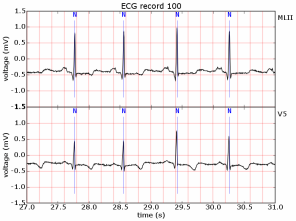pywfdb
Pywfdb is a Python module for accessing PhysioBank database of physiologic signals. It wraps WFDB library, providing easy, Object-Oriented interface.
1. Download
Current, initial release of pywfdb is available for download:
pywfdb-0.1.0.zip
There is also precompiled binary version for Windows.
pywfdb-0.1.0.win32-py2.4.exe
2. Install
If you want to instal pywfdb from source you need to download WFDB library source code. Direct link to the latest version is http://www.physionet.org/physiotools/wfdb-no-docs.tar.gz
After downloading you have to:
Unpack WFDB library files, preferably to pywfdb directory.
Configure WFDB library with --without-netfiles switch, for example:
./configure --without-netfiles --static --static_only --prefix=. --mandir=.
Edit paths in setup.py to point to WFDB lib source and header files. If You have unpacked files to wfdbpy directory, the defaults should work.
execute python setup.py script:
python setup.py install
3. Documentation
Sample Python session with pywfdb may look like this:
>>> import pywfdb >>> record = pywfdb.Record("d:/mitdb/100") >>> print record.signal_names ('MLII', 'V5') >>> record.read('MLII', 1018, 5) # read 5 samples beggining from sample 1018 [-0.38, -0.375, -0.375, -0.375, -0.375] >>> annotation = record.annotation() >>> for ann in annotation.read(0, int(record.frequency) * 2): # read two first seconds ... print ann.time, ann.type, ann.typestr, ann.isqrs, ann.description ... 18 28 + False Rhythm change 77 1 N True Normal beat 370 1 N True Normal beat 662 1 N True Normal beat
See also module documentation generated from Pyrex source or check out some examples:
4. License
Pywfdb is licensed under GPL license.
5. Contact
If you need support, have improvement proposal or just using this library in your software, feel free to contect me directly.
Filip Wasilewski, <filipwasilewski@gmail.com>
